Damage from 'Kristallnacht' greatly overstated by world press
Pedestrians walk along a city shopping street taking subdued notice of the broken store windows--possibly even unaware of what was the cause of the damage. Even though much glass was broken, there was little looting. Most of the shops were insured so the problem was mainly for the insurance companies, to which Reichsminister Hermann Goering addressed himself in the following days and weeks.
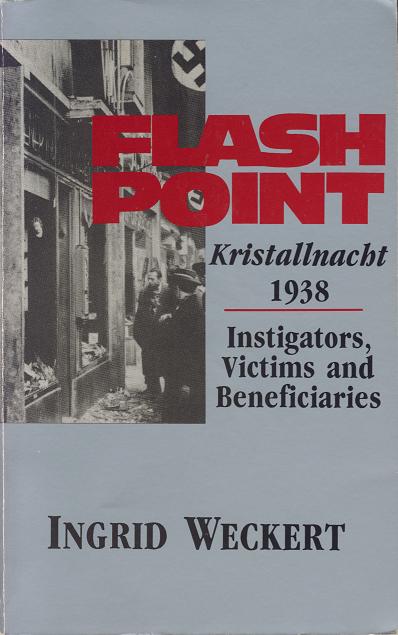 FLASHPOINT Kristallnacht 1938: Instigators, Victims and Beneficiaries by Ingrid Weckert
FLASHPOINT Kristallnacht 1938: Instigators, Victims and Beneficiaries by Ingrid Weckert
Translated by Mr. Carl Hottelet from the original German
English translation Copyright 1991 by Institute for Historical Review in arrangement with Grabert Verlag, Tübingen, Germany
By Carolyn Yeager
Part Five
IN CHAPTER 10, INGRID WECKERT, out of an excess of fairness, wants us to know that some Germans went along with the rioting. Resentments from the past, the Weimar era, still lingered. And Jews still retained inordinate wealth in Germany compared to Germans. In the countryside, some farmers joined in the destruction—during the depression years, they especially had been targeted and oppressed by Jewish cattle dealers, private money lenders, and credit institutions, and many had lost their farms.
But the issue is not the particpants as much as the ringleaders and instigators; there, all signs point to a foreign control center. The judicial proceedings that were carried out after 1945 revealed the same testimony again and again: Persons unknown to them, strangers to the community, led the disturbances and riled up the people. In a few cases there were exceptions to this, such as the former SA man whom it was found had been suspended in 1934 because of bad repute, or the “roving SS band” whose commander was a mental patient.
But on November 10, 1938 nothing was clear. Adolf Hitler first learned of the synagogue burning in Munich well after midnight. He summoned the chief of police and ordered him to put an end to all such activities as quickly as possible, and to prevent more. Every higher Party official was scrambling to quell the disturbances. Joseph Goebbels was left with the difficult task of explaining what had taken place to the world. Thus, mistakes were made
Goebbels went back to Berlin that night in his capacity as Gauleiter. As soon as he arrived and learned from his deputy of similar damage in the capital, he hurried directly to the Propanganda Ministry and issued a pronouncement to the people:
The justifiable and understandable outrage of the German people at the foul and cowardly Jewish assassination of a German diplomat was vented to a great extent last night. The entire population is now called upon strictly to desist immediately from all further demonstrations and actions, of whatever nature, against the Jews. Definitive answer to the Jewish assassination will be made by the law or by decree. (p. 96)
The very next day, on November 11, Dr. Goebbels was back in Munich and appeared with Hitler and Deputy Rudolf Hess at a press conference for foreign correspondents. There, Goebbels characterized the Kristallnacht pogrom as an understandable, “spontaneous” eruption of Teutonic anger against Jews:
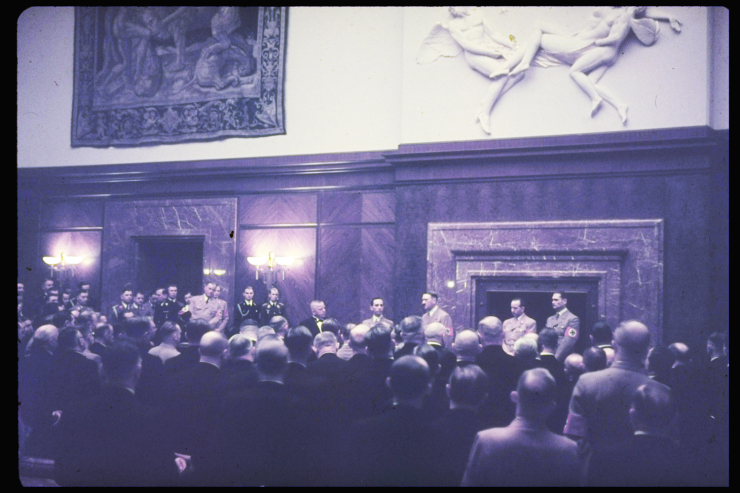
Joseph Goebbels and Adolf Hitler at left of fireplace, Rudolf Hess on far right hold a press conference at the Führerbau in Munich, Nov. 11, 1938. (Time-Life)
It is an intolerable state of affairs that within our borders and for all these years hundreds of thousands of Jews still control whole streets of shops, populate our recreation spots and, as foreign apartment owners, pocket the money of German tenants, while their racial comrades abroad agitate for war against Germany and gun down German officials. (As quoted by Time-Life)
This fed the international media what they wanted, making it harder to revise such a narrative when more considered accounts were brought to light.
Damage assessment
The foreign press carried stories that bordered on the hallucinagenic:
“Hordes, howling and screaming, moved from store to store …,” “...the crash of roll-shutters being broken open …,” “...smashed windows and overturned furniture, intermingled with screaming jubilation...” “all the synagogues in Germany, without exception, were set on fire …,” and so on. (p. 96)
The media went wild and continued to repeat that “all” synagogues were burned, and “all” Jewish shop windows were smashed. In answer, at the time of publication of this book, three different “damage reports” could be cited by Weckert.
-
A report alleged to have been made by Heydrich to Hermann Goering on Nov. 11, 1938.
-
Parts of the largely desroyed minutes of a meeting at the Air Ministry on Nov. 12, 1938.
-
A report of the NS Party Supreme Court to Goering of February 13, 1939.
The numbers differ on each report. The many problems with the first one include: It is a “copy” from Nuremberg, made on an English typewriter, on the letterhead of the Chief of the Security Police (Heydrich) with no other accreditation, only at the lower edge of the last page the words “CERTIFIED TRUE VOPY” (sic). The damage reported was:
815 business establishments destroyed;
19 burned or otherwise destroyed department stores;
171 burned or destoyed dwelling houses;
191 burned synagogues;
76 demolished synagogues;
20,000 Jews taken into custody;
36 fatalities, 36 seriously injured.
The report is signed “Heyer,” without indication of rank or function.
Weckert points out the many problems with this “copy” (too many for me to mention here) beginning with the letterhead being obsolete with an outdated phone no. and other errors – to the signature “Heyer.”
It seems apparent to me that “Heyer” was a misunderstanding of the name Heydrich by the typist, which speaks to the general sloppiness of the work standard at Nuremberg.
[I've looked into the background of the Americans at Nuremberg in earlier years for some of my radio programs, and was shocked, both at the quality of the work that was accepted there and the attitude & behavior of the workers. I learned there was a party atmosphere among the very large American contingent at the IMT. The secretaries were encouraged to behave as though on holiday, enjoying sightseeing trips, parties and expected to entertain the visiting senators and other VIPs, as well as carrying on affairs with the regular staff lawyers and prosecutors. The quality of the work done was substandard, probably because everything submitted by the prosecution was accepted, no questions asked. Who could question it? -cy]
The second report is the minutes of the meeting in the Air Ministry on Nov 12, 1938.
During a regular meeting on the Four Year Plan, Hermann Goering asked Reinhard Heydrich a question: “How many synagogues, in fact, were burned down?” This question was incomprehensible, remarks Weckert, since Goering would have gotten Heydrich's report from the day before--but the minutes show that Heydrich replied, “Altogether 101 synagogues destroyed by fire; 76 synagogues demolished; 7500 stores destroyed in the Reich.”
The discrepancy between 101 burned synagogues on the 12th versus 191 on the 11th might be a typing error (though trained German secretaries did not make errors, those Americans & other Allies working in the IMT 'forgery factory,' as Weckert called it,' certainly did) but the difference between 834 businesses/stores damaged on the 11th and 7500 on the 12th is a bit too far a stretch. This is accepting the premise that the outdated Heydrich letterhead on the 11th is authentic.
Weckert devotes a short chapter (12) to explaining that a synagogue cannot be compared to a Christian church in that it is considered a "schul" rather than a house of God. The only house of God the Jews ever possessed was the Temple in Jerusalem. Thus a synagogue is a secular structure--an assembly hall and schoolrooms, and could be any convenient living room in a family home in smaller communities. Thus, some of the synagogues reported damaged or destoryed could have been such a commercial room or private home used as a synagogue on the Sabbath. Our Christianized sentiments have led us to believe a synagogue is similar to our churches, but it is only the scrolls of the "holy Torah," that may be contained therein, that are "sacred," says Weckert. That's why removing the scriptural scrolls (and other sacred or valued objects) from the buildings was the first priority and was generally successfully achieved.
The third report is from the Party Supreme Court to Goering on Feb. 13, 1939.
The National Socialist Supreme Court investigation into the incidents committed during Kristallnacht found that 91 cases of manslaughter were said to have occurred. The orignal document was unavailable to Ingrid Weckert; she could only view it on microfilm on a reading apparatus that prevented determining its genuineness.(p. 68)
These dubious figures are the only basis for determining the extent of the damage. This was exploited by Dr. Nahum Goldmann, President of the World Jewish Congress in 1952 when he demanded five hundred million dollars [that is half a billion!] from the Federal Republic of Germany for the reconstruction of the synagogues and other Jewish establishments destroyed or damaged during Kristallnacht. When the Foreign Office protested so vast a sum should have some juridical justification, Goldmann cynically retorted,
“You find he juridical justification, or not. I want the money, not the justification.” (p. 69)
When Adenauer agreed with the Foreign Office, Goldmann said:
“Five hundred million dollars is a smooth, round sum to which nobody will have an objection.”
Adenauer apparently was convinced. Another smooth, round number of 6,000,000 should cause no wonderment, writes Weckert.
It must be pointed out that in 1938 there were still some 1,420 synagogues standing unharmed in Germany. One hundred seventy-seven is neither “all”, nor “most, nor even a large fraction, but only 12% of the total. This is similar to the Jewish shops that were “demolished.” Even the higher 7500 figure from the Nov. 12 report would have been out of a total of some 100,000 Jewish shops and department stores in Germany in 1938. Hardly “all.”
Extent and Effect on Jews of the Destruction
Wecketwrites:
In the event, only a handful of individuals were involved. While it is impossible to determine precise numbers, practically it has to be far lower than those implied by the free-wheeling stories we are told. Estimates of the number of demonstrators range from a total of 5,000 to a total of 7,000. The higher estimate would represent barely 0.001%—one-thousandth of one percent—of the German population at the time. If one wanted to proceed from the supposition that the demonstrators were all Brownshirts (which, of course, was not the case), they would have made up less than 0.01.5% (one and a half hundredths of one percent) of Brownshirt enrollment. (p. 95)
These numbers should aid in putting the Kristallnacht in correct perspective. The scope and significance of the acts were far less than what was being asserted about them still in 1990 when this translation was made. The transgressions were no more than sporadic. Only a few towns and smaller localities were troubled by them at all. In large cities, like Berlin, where numerous shops were destroyed and synagogues set on fire, significent elements of the population knew nothing of what had happened during the night. For example, the rector of a large Jewish middle school, Heinemann Stern, said he had noticed a burning synagogue that morning as he rode past it on a suburban train. The students had appeared in full number and had no knowledge of the happenings of the night before. It was not until the lunch break that the school's exclusively Jewish teaching staff was informed of the occurrences.
There is ample evidence that people of the neighborhoods defended themselves vigorously, and were by no means under the impression that the incidents were ordered “from higher up,” and therefore had to be suffered in silence. (p. 94)
Nor is it true, as is asserted so often, that the Jewish population lost its confidence in the constitutional state overnight. Jews, both young and old, reported incidents of abuse to the police and the courts took action. Culprits were expelled from the Party, and from the SA, or – in less serious cases – reduced in rank.
Next, we will look at other "Telex messages" & documents, and the role of the Brownshirts.
Category
Germany, Historical Revisionism, Kristallnacht- 945 reads

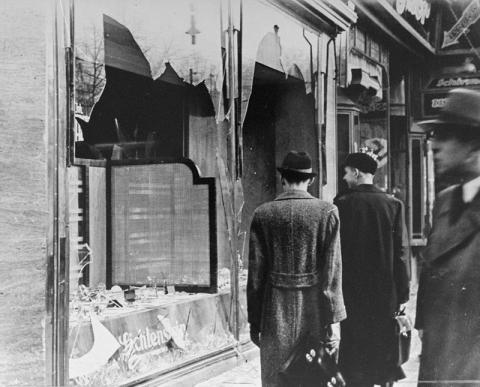





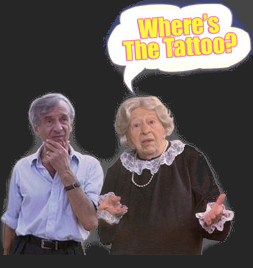
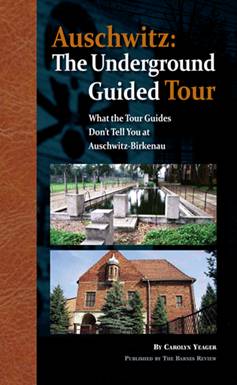

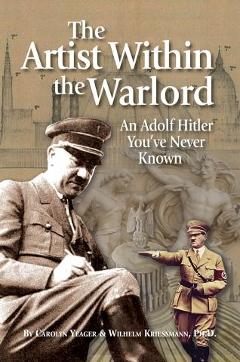
Comments
The pretext for War
Thanks for another great article and the courage to stick your hand in this muck propaganda to try to find some glimmer of the truth. Dealing with the Jewish propaganda is dirty work. The one thing that I keep reminding myself of and that I try to point out to people who haven't a clue (most Christian apologists, for example) is the headlines of 1933, "Judaism Declares War On Germany." (Did you report that?) Anyway, the Jews were calling for the economic destruction of Germany and a complete boycott of all things German. That means they were calling for the destruction of the German people But this seems to have been lost to the historical dialogue. Is it true or did I just dream it? But if it is true, does anyone not see a problem with blaming Germans for responding? Maybe that is why it is suppressed.
Guess you missed that one, Al
Guess you missed that one, Al. https://carolynyeager.net/jewish-declaration-war
Thanks
I didn't miss it, I just forgot where I had read it! Thanks so much.
These headlines are important to establish what Germany was reacting to during the 30's. I try and bring this to my religion class every semester. I just think the Jews were traitors to their country. And now with the holocaust propaganda, they want to get paid, too.
Until you, I didn't know there was an information blackout that prevented the Americans from knowing what was really going on. Well, the Jews got their war, and Germany was blamed for it.
Keep reading, Al.
Keep reading, Al. There's more to come, and the whole thing becomes completely clear. At least to me it does.
Was there an insurance that
Was there an insurance that they had collected on and then had to pay back after a few years? I had one time read something like that.
If you read it once you can read it again
Why don't you look it up and find out for yourself? I'm not Questions & Answer Central here.
Oranienburgstrasse Synagogue
Was little if at all damaged during Kristallnacht. It was destroyed (gutted) by bombs in an Allied air raid.
You're right!
Wow. I wuz tricked! That photo is one of the first you find whenever you look up Kristallnacht on the Internet. I removed it and replaced it with the photo of the broken shop windows. This is such a great example, though, of how dishonest the media is--can't be trusted at all--ever.
https://www.hagalil.com/deutschland/berlin/gemeinde/synagoge5.htm says: "On the Kristallnacht it remained undamaged because a courageous Berlin police officer preserved it" by chasing away a gang that was causing damage inside. Services continued to take place until 1940.
In November 1943 it was heavily damaged by Allied bombing.
This bomb damage is what is portrayed as Kristallnacht damage on the Internet.